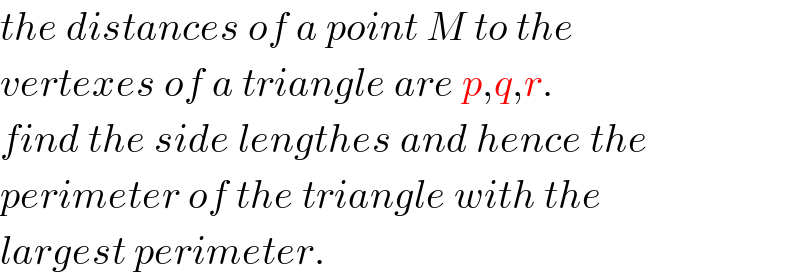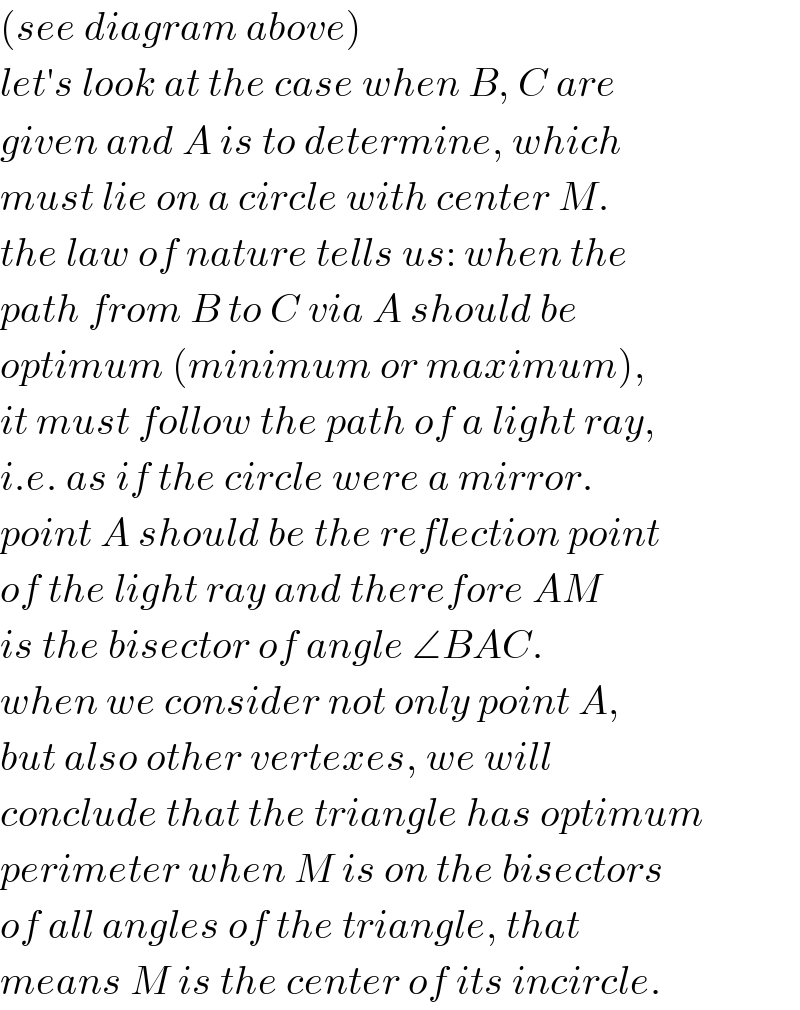
Question and Answers Forum
Question Number 62542 by mr W last updated on 22/Jun/19

Commented by mr W last updated on 22/Jun/19

Answered by mr W last updated on 23/Jun/19
![i think M should be center of incircle such that perimeter is maximum. let k=radius of incircle ∠A=2 sin^(−1) (k/p) ∠B=2 sin^(−1) (k/q) ∠C=2 sin^(−1) (k/r) ∠A+∠B+∠C=π ⇒sin^(−1) (k/p)+sin^(−1) (k/q)+sin^(−1) (k/r)=(π/2) ⇒cos (sin^(−1) (k/p)+sin^(−1) (k/q))=cos ((π/2)−sin^(−1) (k/r)) (√((1−(k^2 /p^2 ))(1−(k^2 /q^2 ))))−(k^2 /(pq))=(k/r) (√((1−(k^2 /p^2 ))(1−(k^2 /q^2 ))))=(k/r)+(k^2 /(pq)) (1−(k^2 /p^2 ))(1−(k^2 /q^2 ))=(k^2 /r^2 )+(k^4 /(p^2 q^2 ))+((2k^3 )/(pqr)) ((2k^3 )/(pqr))+((1/p^2 )+(1/q^2 )+(1/r^2 ))k^2 −1=0 k^3 +3((p^2 q^2 +q^2 r^2 +r^2 p^2 )/(6pqr))k^2 −2((pqr)/4)=0 ⇒k^3 +3uk^2 −2v=0 k=s−u ⇒s^3 −3u^2 s+2(u^3 −v)=0 s=2u sin {(1/3) sin^(−1) (1−(v/u^3 ))+((2nπ)/3)} k=u[2 sin {(1/3) sin^(−1) (1−(v/u^3 ))+((2π)/3)}−1]>0 ⇒k=((p^2 q^2 +q^2 r^2 +r^2 p^2 )/(6pqr))[2 sin {(1/3) sin^(−1) (1−((54p^4 q^4 r^4 )/((p^2 q^2 +q^2 r^2 +r^2 p^2 )^3 )))+((2π)/3)}−1] ⇒a=(√(q^2 −k^2 ))+(√(r^2 −k^2 )) ⇒b=(√(r^2 −k^2 ))+(√(p^2 −k^2 )) ⇒c=(√(p^2 −k^2 ))+(√(q^2 −k^2 ))](Q62558.png)
Commented by ajfour last updated on 22/Jun/19

Commented by mr W last updated on 23/Jun/19

Commented by mr W last updated on 23/Jun/19

Commented by mr W last updated on 23/Jun/19

Commented by mr W last updated on 23/Jun/19

Commented by mr W last updated on 23/Jun/19

Commented by mr W last updated on 23/Jun/19

Commented by ajfour last updated on 23/Jun/19

